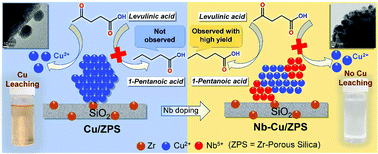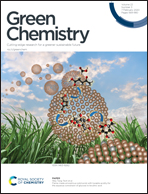One-pot direct conversion of levulinic acid into high-yield valeric acid over a highly stable bimetallic Nb-Cu/Zr-doped porous silica catalyst†
Abstract
The direct conversion of levulinic acid (LA) to valeric biofuel is highly promising for the development of biorefineries. Herein, LA is converted into valeric acid (VA) via one-pot direct cascade conversion over non-noble metal-based Nb-doped Cu on Zr-doped porous silica (Nb-Cu/ZPS). Under mild reaction conditions (150 °C and 3.0 MPa H2 for 4 h), LA was completely converted into VA in high yield (99.8%) in aqueous medium with a high turnover frequency of 0.038 h−1. The Lewis acid sites of ZPS enhanced the adsorption of LA on the catalyst surface, and both the Lewis and Brønsted acidity associated with Nb2O5 and the metallic Cu0 sites promoted catalysis of the cascade hydrogenation, ring cyclization, ring-opening, and hydrogenation reactions to produce VA from LA. The bimetallic Nb-Cu/ZPS catalyst was also effective for the conversion of VA into various valeric esters in C1–C5 alcohol media. The presence of Nb2O5 effectively suppressed metal leaching and coke formation, which are serious issues in the liquid-phase conversion of highly acidic LA during the reaction. The catalyst could be used for up to five consecutive cycles with marginal loss of activity, even without catalyst re-activation.



 Please wait while we load your content...
Please wait while we load your content...